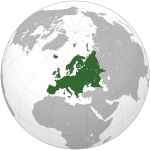Swítsàlandì
Ìrísí
(Àtúnjúwe láti Switzerland)
Swiss Confederation [Schweizerische Eidgenossenschaft] error: {{lang}}: text has italic markup (help) (de) [Confédération suisse] error: {{lang}}: text has italic markup (help) (fr) [Confederazione Svizzera] error: {{lang}}: text has italic markup (help) (it) [Confederaziun svizra] error: {{lang}}: text has italic markup (help) (rm) [Confoederatio Helvetica] error: {{lang}}: text has italic markup (help) (la) | |
|---|---|
Motto: (unofficial) "One for all, all for one" Faransé: Un pour tous, tous pour un Ítálì: [Uno per tutti, tutti per uno] error: {{lang}}: text has italic markup (help) | |
![Ibùdó ilẹ̀ Swítsàlandì (dark green) on the European continent (dark grey) — [Legend]](http://upload.wikimedia.org/wikipedia/commons/thumb/6/61/Europe-Switzerland.svg/250px-Europe-Switzerland.svg.png) Ibùdó ilẹ̀ Swítsàlandì (dark green) on the European continent (dark grey) — [Legend] | |
| Olùìlú | Bern[1] |
| Ìlú tótóbijùlọ | Zürich |
| Àwọn èdè ìṣẹ́ọba | German, French, Italian, Romansh[2] |
| Orúkọ aráàlú | Swiss |
| Ìjọba | Direct democracy Federal parliamentary republic |
| Moritz Leuenberger Micheline Calmy-Rey Hans-Rudolf Merz (Pres. 09) Doris Leuthard (VP 09) Eveline Widmer-Schlumpf Ueli Maurer Didier Burkhalter | |
| Corina Casanova | |
| Aṣòfin | Federal Assembly |
| Council of States | |
| National Council | |
| Independence | |
| 1 August[3] 1291 | |
• de facto | 22 September 1499 |
| 24 October 1648 | |
• Restored | 7 August 1815 |
| 12 September 1848[4] | |
| Ìtóbi | |
• Total | 41,284 km2 (15,940 sq mi) (136th) |
• Omi (%) | 4.2 |
| Alábùgbé | |
• 2009 estimate | 7,739,100[5] (94th) |
• 2007 census | 7,593,500 |
• Ìdìmọ́ra | 186.5/km2 (483.0/sq mi) (65th) |
| GDP (PPP) | 2008 estimate |
• Total | $315.768 billion[6] (38th) |
• Per capita | $43,195[6] (7th) |
| GDP (nominal) | 2008 estimate |
• Total | $500.260 billion[6] (21st) |
• Per capita | $68,433[6] (4th) |
| Gini (2000) | 33.7 medium |
| HDI (2007) | ▲ 0.960[7] Error: Invalid HDI value · 9th |
| Owóníná | Swiss franc (CHF) |
| Ibi àkókò | UTC+1 (CET) |
• Ìgbà oru (DST) | UTC+2 (CEST) |
| Ojúọ̀nà ọkọ́ | right |
| Àmì tẹlifóònù | +41 |
| ISO 3166 code | CH |
| Internet TLD | .ch |
Swítsàlandì tabi Orile-èdè Ìdàpapọ̀ ilẹ̀ Swítsàlandì je orile-ede ni apa iwoorun Europe.

|
Àyọkà yìí tàbí apá rẹ̀ únfẹ́ àtúnṣe sí. Ẹ le fẹ̀ jù báyìí lọ tàbí kí ẹ ṣàtúnṣe rẹ̀ lọ́nà tí yíò mu kúnrẹ́rẹ́. Ẹ ran Wikipedia lọ́wọ́ láti fẹ̀ẹ́ jù báyìí lọ. |
Itokasi
[àtúnṣe | àtúnṣe àmìọ̀rọ̀]- ↑ De jure "federal city"; de facto capital. Because of historical federalist sensibilities, Swiss law does not designate a formal capital, and some federal institutions such as courts are located in other cities.
- ↑ Federal Constitution Archived 2009-11-01 at the Wayback Machine., article 4, "National languages" : National languages are German, French, Italian and Romansh; Federal Constitution Archived 2008-09-19 at the Wayback Machine., article 70, "Languages", paragraph 1: The official languages of the Confederation are German, French and Italian. Romansh shall be an official language for communicating with persons of Romansh language.
- ↑ Traditional. The Federal Charter only mentions "early August" and the treaty is a renewal of an older one, now lost.
- ↑ A solemn declaration of the Tagsatzung declared the Federal Constitution adopted on 12 September 1848. A resolution of the Tagsatzung of 14 September 1848 specified that the powers of the institutions provided for by the 1815 Federal Treaty would expire at the time of the constitution of the Federal Council, which took place on 16 November 1848.
- ↑ "Population size and population composition". Swiss Federal Statistical Office. Swiss Federal Statistical Office, Neuchâtel. 2009. Retrieved 2009-08-27.
- ↑ 6.0 6.1 6.2 6.3 "Switzerland". International Monetary Fund. Retrieved 01 October 2009. Check date values in:
|access-date=(help) - ↑ Human Development Report 2009. The United Nations. Retrieved 5 October 2009



